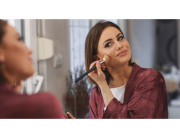Eye shadow is a cosmetic applied primarily to the eyelids to attract attention to the wearer’s eyes.
Natural eye shadow can range anywhere from a glossy shine to one’s eyelids, to a pinkish tone, or even a silver look. The earliest direct archeological evidence for eye makeup dates back to predynastic Egypt (c. 5000 – 4000 BCE). Over the years many women have used burnt matches to intensify their eye makeup. Women would often dust rice powder to hide any imperfections or freckles on their faces. Eyeshadow or eye paint was very popular during the Victorian era (c. 1837 to c. 1901); less was more.
Eye shadow can also be applied under the eyes, cheeks, or to brow bones. The earliest evidence of a commercial product called ‘eye shadow’ dates to the 1910s in the United States. Cosmetics company founder Elizabeth Arden visited beauty salons in Paris in 1912, studying the products and techniques. In 1914 she introduced eye shadow to her own salons in the US. Eye shadow was advertised as ‘Arden Eye Shadow’ in newspapers as part of the Arden Venetian Preparations range of cosmetics in 1919. The product was sold as ‘Eye Sha Do’ in 1922, but by the 1930s, eye shadow had become the common name used by Elizabeth Arden, Inc. and other cosmetic companies such as Helena Rubinstein Incorporated and Max Factor.
Eye shadow has gone through many different phases, for example during the 1920s when smoky eyes were in trend or in the 1930s when people added many colors to their eyeshadow looks. Eye shadows typically consist of four types of ingredients: base fillers, binders, slip, and preservatives. In order to make eye shadow, there must be a balance between the fillers and binders. Base fillers are usually minerals such as mica, talc, or kaolin clay, which add bulk and texture to eye shadow. They make up about 30% of eye shadow powders and 25% of cream eye shadows. Mica absorbs moisture, gives the eye shadow shine and luster, and makes it opaque. Mica powders, iron oxides, and clays can give color pigments to eye shadows.
Binders help eye shadow adhere and stay attached to the skin. Eye shadows can have dry or liquid binders. Zinc and magnesium, which are both white powders, are commonly used as dry binders. Zinc also adds color and can be used to increase the thickness of the eyeshadow. Silicone, paraffin wax, mineral oil, or vegetable oils may be used as liquid binders. Slip allows eye shadow to glide across the skin smoothly. Products may use silica or nylon, which are fine, colorless powders. Other types of slip include dimethicone, boron nitride, or bismuth oxychloride. Preservatives help products stay bacteria-free and extend their lifespan. Common preservatives in eye shadow are glycol and tocopherol.
Eye shadow is usually applied with brushes, sponges, or fingers. Different brushes can be used for different application techniques and effects, such as packing on eye shadow.







Add Comment
You must be logged in to post a comment.